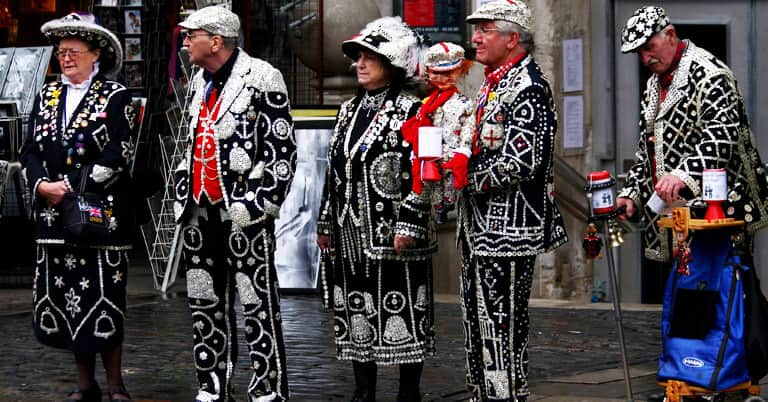The Pearly Kings and Queens have been a vibrant and colourful part of London’s culture for over 150 years, but who are they exactly and why do they wear costumes covered with buttons?

Pearly history
The history of the Pearlies dates back to the Victorian era, when street traders in London, known as costermongers, would sew buttons up the seams of their trousers to distinguish themselves and denote their status. These costermongers were proud of their working class roots and established the ‘Lambeth Walk’ parade. As a tight-knit community, they were known for helping each other out.
A local rat catcher and street sweeper, Henry Croft, got to know the costermongers and was inspired by the costumes they wore. In 1875, Henry decided to make a similar costume of his own, covering it with 60,000 smoked, mother-of-pearl buttons. Various theories abound as to where Henry obtained the buttons. Some say he picked them up off the streets, while others say he found an abandoned haul of buttons on the bank of the River Thames.
Henry created the first full costume made from pearl buttons, known as a smother suit. He created a design on the suit with the slogan ‘pity the poor’, in the hope that he could collect money for the orphanage he grew up in. The costume quickly gained a lot of attention, and before long Henry, with the help of the costermongers, was raising funds for hospitals and other charitable needs.
The Pearly movement grew and by 1911, an organised society for the Pearly Kings and Queens was formed. At this time, 28 London boroughs had their own Pearly King and Queen, most stemming from the costermonger community. When Henry Croft died in 1930, 400 Pearlies attended his funeral.
Pearly traditions
The Pearly culture is still alive and strong in London today, with several active groups in operation. Pearly titles and traditions are passed down through families, of which there are currently around 30 Pearly families in the Capital.
Elaborate button-covered costumes are still worn by Pearly Kings and Queens. Buttons are sewn into the costume to represent specific symbols, designs or words, such as doves for peace, a heart for charity or a horseshoe to bring good luck. As many as 30,000 buttons can cover an outfit, often weighing around 30 kgs or more. Hats adorned with ostrich feathers are also worn by the Queens – or ‘donahs’, as the females are often called.
Donkeys are of special significance to the Pearlies, as they pulled costermongers’ carts to the market. The harvest festival is also important to Pearly culture and annual festivities include donkeys and carts, marching bands and maypole dancing.
Charity work
Charitable work is still a vital part of the Pearly King and Queen culture today. Outfits are worn by the Pearlies when raising funds for charity, but also for other occasions such as weddings, funerals and christenings.
Pearly inspiration
Although Pearly costumes are rooted in working class culture, they have become something of an iconic symbol in more recent times, revered by high-profile fashion designers and costume makers alike. Boris Johnson is said to be a fan of the Pearlies, and Kylie Minogue wore her own Pearly costume at the Queen’s Jubilee Concert. The Pearlies even put in an appearance at the 2012 Olympics Opening Ceremony in London.
Costumes worn by the Pearly Kings and Queens can be seen on display at the Museum of London, reinforcing the history of this unique and iconic British culture.
If you would like to immerse yourself in Pearly culture at the Museum of London, grab a few like-minded buddies and hire a top-notch minibus from H&H Van Hire.


